As the icy winds howled and the snow began to fall in earnest, Maryland residents braced themselves. Not knowing it would soon become the biggest snowstorm ever to hit their state from March 29 to 30th of, 1942. With a staggering accumulation of snowfall, transportation came to a standstill, schools, and businesses shut their doors, and even the hardiest of locals found themselves forced to stay indoors.
Yet amidst the chaos and bitter cold, there was also a sense of awe and wonder at the sheer magnitude of the storm. A reminder that nature can still hold us in thrall even in the modern age. Join us as we recount this historic winter blast’s harrowing and unforgettable events.

©Jon Bilous/Shutterstock.com
What is the Typical Weather for the State of Maryland During March?
March is a transitional month for Maryland’s weather. The state moves away from the cold winter temperatures and towards the milder weather of spring. Despite this transition, temperatures in Maryland during March can still be relatively cold. They have an average high temperature of around 52°F and an average low temperature of around 40°F.
March in Maryland can be pretty unpredictable in terms of precipitation. Some years, the state experiences very little precipitation, while others can be very wet. On average, you can expect around 3 to 4 inches of precipitation throughout the month, which can be rain or snow, depending on the temperature. Although snow is not as common in Maryland during March, you should still be prepared for it, as occasional snowfall events happen throughout the state.
Given the cold temperatures and potential snowstorms during this time, it’s essential to take precautions to stay warm and safe while enjoying outdoor activities. Dressing appropriately in a good winter coat, sturdy boots, and warm clothing is crucial to ensure you stay comfortable and protected from the elements.

©Roman Samborskyi/Shutterstock.com
What was the Biggest Snowstorm to Ever Hit Maryland During March?
The snowstorm in Maryland on March 29th and 30th in 1942 is considered a significant meteorological event in the state’s history. This storm was part of a more extensive weather system that affected a vast area of the eastern United States, leading to heavy snow and blizzard conditions in Maryland.
As per historical accounts, the snowfall began on Sunday, March 29, with light precipitation in the morning. However, as the day progressed, the snow intensified, leading to heavy snowfall and strong winds causing low visibility in several areas. By evening, the storm had further escalated, with gusty winds of up to 50 miles per hour and snowdrifts reaching heights of up to 10 feet in some regions.
The blizzard continued throughout the night and into the morning of March 30, with the snowfall finally tapering off by midday. By the time the storm had passed, some areas of Maryland had received over two feet of snow, and the high winds had caused significant drifting, making many roads and highways impassable.
The March 29 to 30th, 1942, snowstorm significantly impacted Maryland, disrupting travel and commerce across the state and causing widespread power outages. The storm also had tragic consequences, with several deaths reported due to exposure and accidents caused by the storm.
Occurring almost 80 years ago, the snowstorm of March 29 to 30th, 1942, is an important historical event in Maryland’s history. It serves as a reminder of the power and unpredictability of nature and the importance of being prepared for extreme weather events.
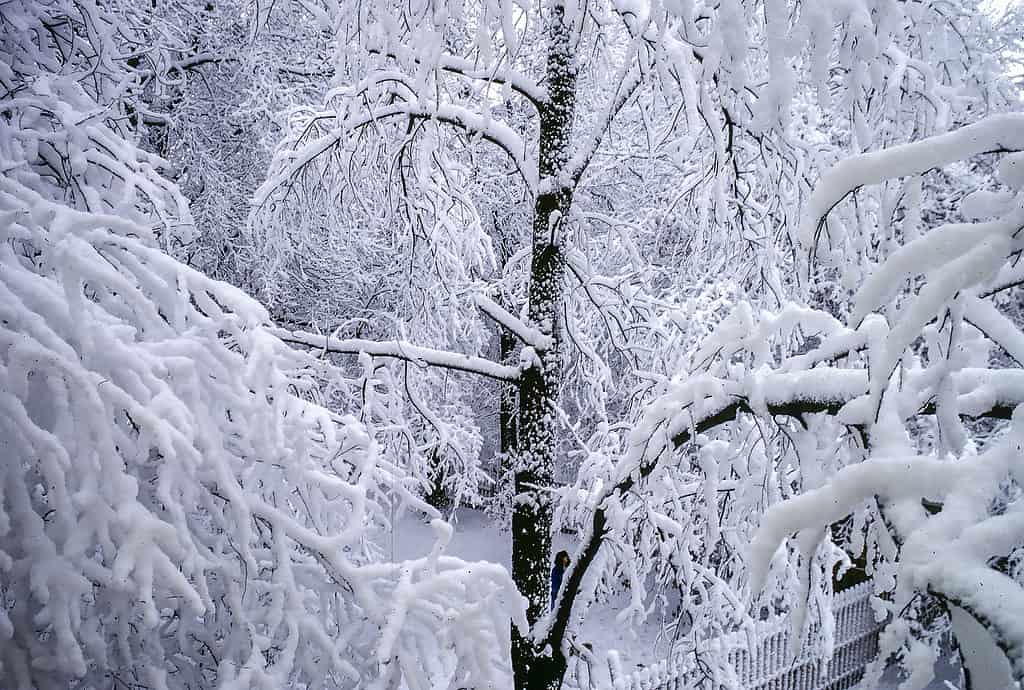
©iStock.com/William Dummitt
How Did the Snowstorm Affect Residents Living in New York?
The snowstorm that hit Maryland significantly impacted the residents living in the region across various sectors, including the economy, agriculture, transport, and mental health.
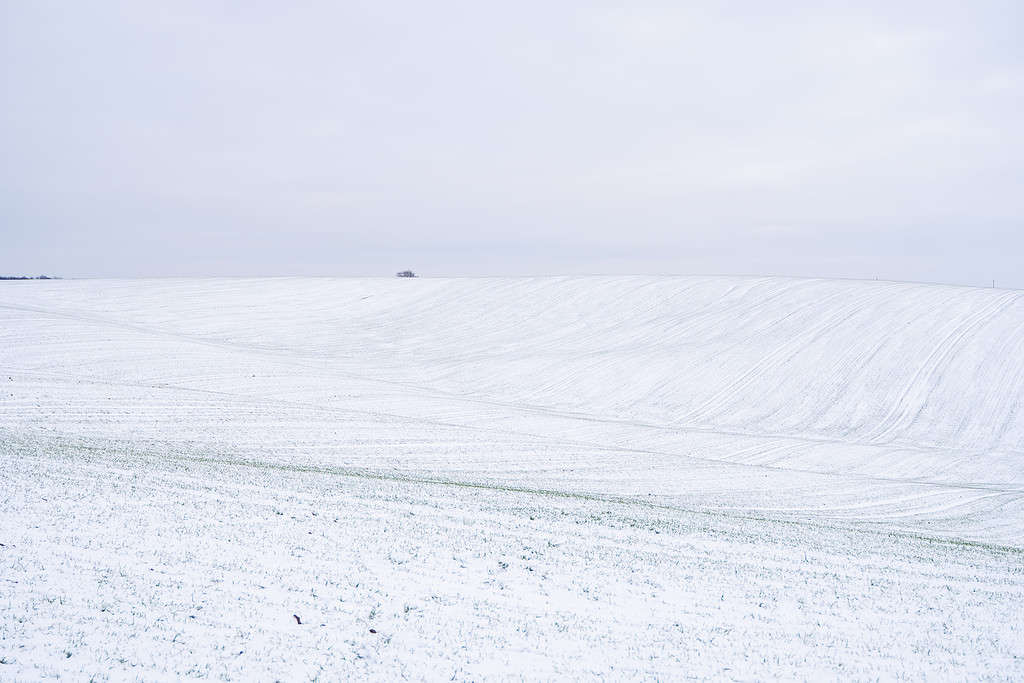
©Volodymyr_Shtun/Shutterstock.com
Economy
The snowstorm caused significant disruptions to the economy of Maryland. Businesses were forced to close due to extreme weather conditions. This resulted in financial losses and a decline in economic activity. The tourism industry also suffered as travel became more challenging due to the snow and ice.
The snowstorm that hit New York affected the tourism industry. Visitors had to cancel or postpone their trips. This negatively impacted businesses that depend on tourism, such as hotels, restaurants, and cultural attractions.
Moreover, the construction industry also suffered as many construction sites had to halt operations due to hazardous weather conditions. This led to delays and increased costs, affecting productivity and completion deadlines. The snow and ice accumulation also made it challenging for construction workers to commute to job sites, further hindering operations.
Agriculture
In some parts of Maryland, farmers could not access their fields due to the weight of the snow and icy conditions. In other areas, livestock was affected due to the extreme cold temperatures that followed the storm. Dairy farms suffered greatly as cows stopped producing milk due to stress from severe weather conditions, resulting in lost income for farmers.
Greenhouses and nurseries in Maryland also experienced significant damage due to this historic winter storm. Greenhouse plastic covering was torn away by powerful winds or crushed by heavy snow accumulation. Thus, exposing local crops to dangerously frigid temperatures. Many nursery owners reported losing entire crop batches. They were unable to protect them from extreme cold and wet weather.
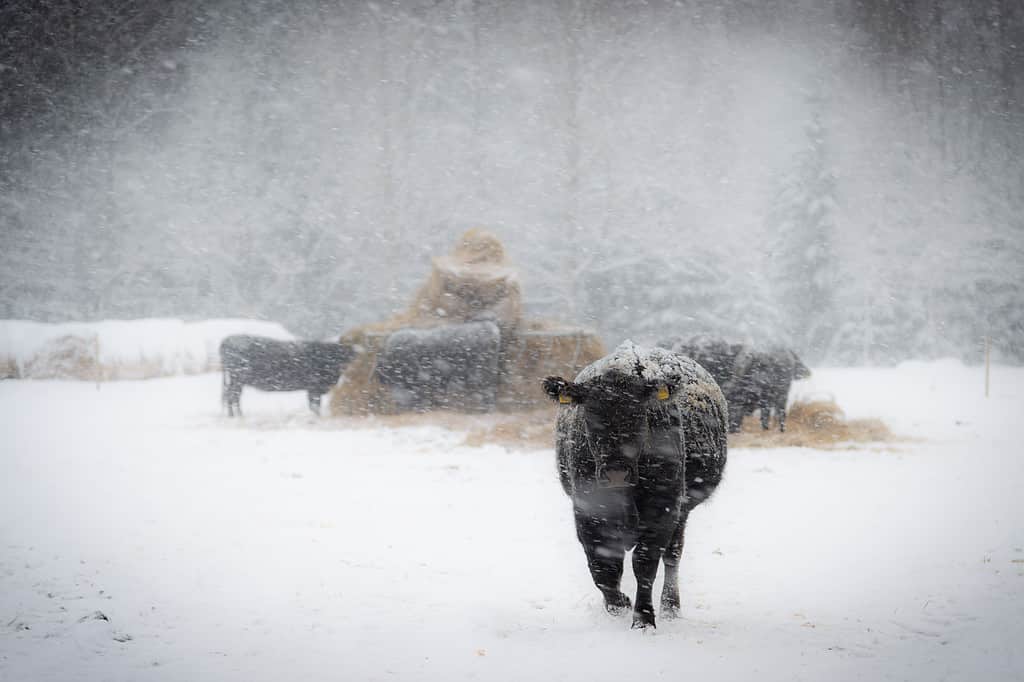
©Mariliis Kutsar/Shutterstock.com
Transport
The snowstorm also caused widespread disruptions in transportation across Maryland. The hazardous road conditions led to numerous accidents and collisions, resulting in delays and cancellations for public transportation, including buses and trains. Commuters faced inconvenience as a result of these disruptions.
The sudden and severe nature of the storm impacted the preparedness of emergency responders. The snow plows typically relied upon for maintaining access and mobility became immobilized due to the significant accumulation of snow. This, regrettably, limited their capacity to respond to calls promptly.
The implications of this were especially concerning for individuals residing in outlying areas. Access to vital resources such as electricity and water would be compromised during power outages caused by heavy wind or ice accumulation.
Additionally, the treacherous conditions of icy roads present a considerable hazard to all drivers, with cars prone to skidding or sliding unexpectedly. This situation is further exacerbated by the likelihood of highways becoming gridlocked and accidents occurring more frequently owing to poor visibility or debris propelled by powerful winds.
Mental Health
Furthermore, the snowstorm had an impact on the mental health of residents in Maryland. Prolonged periods of isolation and cabin fever resulting from the snowstorm can lead to anxiety and stress. The pandemic may have exacerbated these feelings, leading to significant mental health impacts for the residents of Maryland.
How Do Late-Season Snow Storms Impact Wildlife in New York?
Late-season snowstorms can have significant impacts on wildlife in Maryland. The sudden and unexpected arrival of snow and freezing temperatures can be particularly challenging for animals. Many having already begun their spring migration or emergence from hibernation.
One of the most significant impacts of late-season snowstorms on wildlife is the disruption of food sources. Snow can cover or bury vegetation that animals rely on for food, making it difficult for them to find nourishment. Additionally, small animals, such as rodents and insects, may be unable to access their food sources buried beneath the snow.
Heavy snow storms also affect aquatic life as well as land animals. Snow and ice accumulation can alter water temperature and cause disturbances in ecosystems. Cold temperatures and reduced oxygen levels in melted runoff from mountain snows can make it hard for fish to survive in streams and rivers.
Consequentially, fish may suffer from stress if forced into new habitats with different temperatures than those they are used to living in. Contamination from runoff caused by melting snow can degrade the water quality, leading to hazardous conditions for aquatic species.
In addition to the direct impacts of these winter storms on wildlife, they also affect other natural resources. Trees and plants provide habitat for animals throughout Maryland’s forests. Heavy accumulations of wet snow can cause limbs and branches of trees to crack or break off due to excess weight causing injury or death of foliage within these areas.
This disruption not only jeopardizes animals dependent upon this ecosystem but can also lead to larger-scale environmental issues. Soil erosion, nutrient depletion, and flooding during the spring when the snow melts away quickly causing these issues.
How Did the Animals Cope Amid the Snowstorm in Maryland?
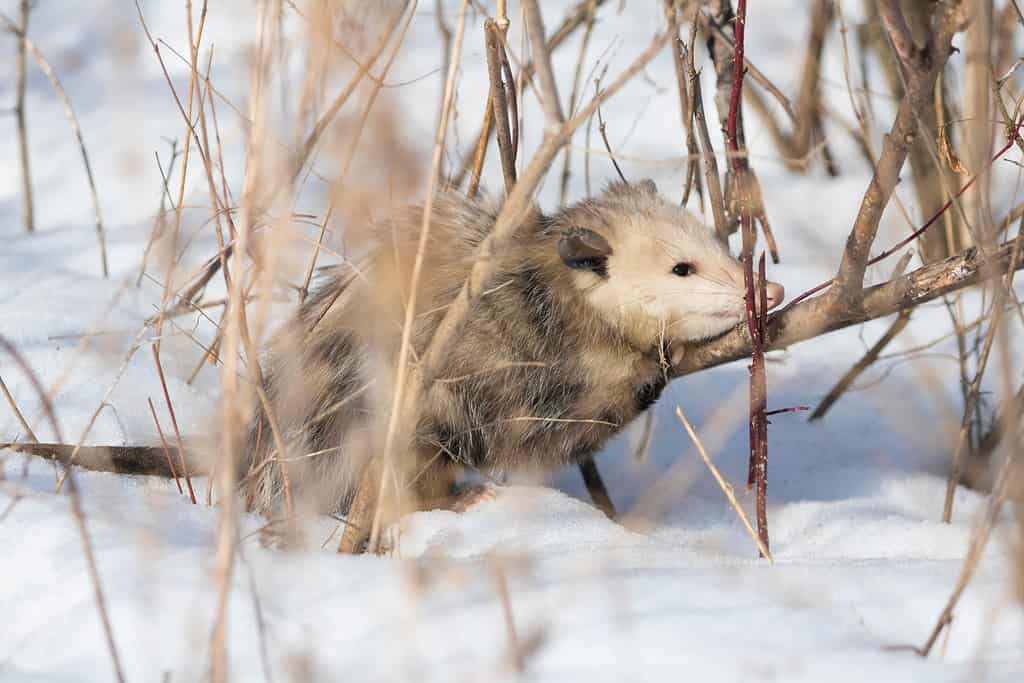
©KB Digital/Shutterstock.com
To survive this historic winter storm, many animals huddled together for warmth and dug through the snowdrifts for food. Some were lucky enough to find shelter in barns or abandoned buildings, while others found refuge in backyards or parks. With that said, here’s how different animals survived the March snowstorm of 1942 in Maryland:
Opossums
Opossums are renowned for their adaptability and resilience, traits that play a crucial role in their survival during cold weather. During winter, opossums construct nests in tree cavities or burrows and reduce their metabolic rate, effectively becoming dormant. This allows them to conserve energy and survive extended periods without access to food or water as they wait out extreme weather conditions.
Shrews
Shrews are small mammals that are similar in appearance to mice. They have a high metabolic rate and a reputation for being very hungry. To endure the snowstorm, shrews likely took advantage of their ability to create burrows underground. These burrows would have provided a haven from the freezing temperatures and a food source. Shrews typically feed on small insects and invertebrates found in the soil and leaf litter.
Moles
To survive the snowstorm, moles employed various strategies to withstand the harsh conditions.
One of the most important adaptations of moles is their ability to construct complex tunnel systems underground. These provide shelter from the elements and a consistent temperature. During the snowstorm, moles likely retreated to their underground tunnels to avoid exposure to the snow and protect themselves from the cold.
In addition, moles are skilled at conserving energy during periods of reduced activity. This would have been crucial during the snowstorm when food sources were scarce. By conserving energy, moles were able to maintain their metabolic processes and avoid starvation.
Bats
Bats, being aerial creatures, might have been particularly vulnerable to the storm. However, these animals have unique adaptations that help them survive the snowstorm.
During the winter months, bats typically enter a state of inertia, similar to hibernation in other animals. During torpor, their metabolic rate slows down, and their body temperature drops, allowing them to conserve energy. In this state, they remain inactive and conserve energy until the weather conditions improve.
Another crucial adaptation that bats possess is their ability to roost in protected locations. Many species of bats roost in caves, rock crevices, and other protected areas where they can shelter from the cold and inclement weather. During the snowstorm, bats would have taken advantage of these roosting sites. Allowing them to avoid exposure to the elements and maintain their body temperature.
Birds
Birds are opportunistic feeders, meaning they can adapt their diet to the available food sources. During the snowstorm, birds may have switched to alternative food sources, such as seeds, berries, or insects, that were still available despite the snow cover.
The ability of birds to migrate, grow thicker feathers, seek protected locations, enter torpor, and adapt their diet was crucial to their survival during the March 1942 snowstorm in Maryland. These adaptations allowed them to maintain their body temperature, conserve energy, and find alternative food sources, despite the harsh winter conditions.
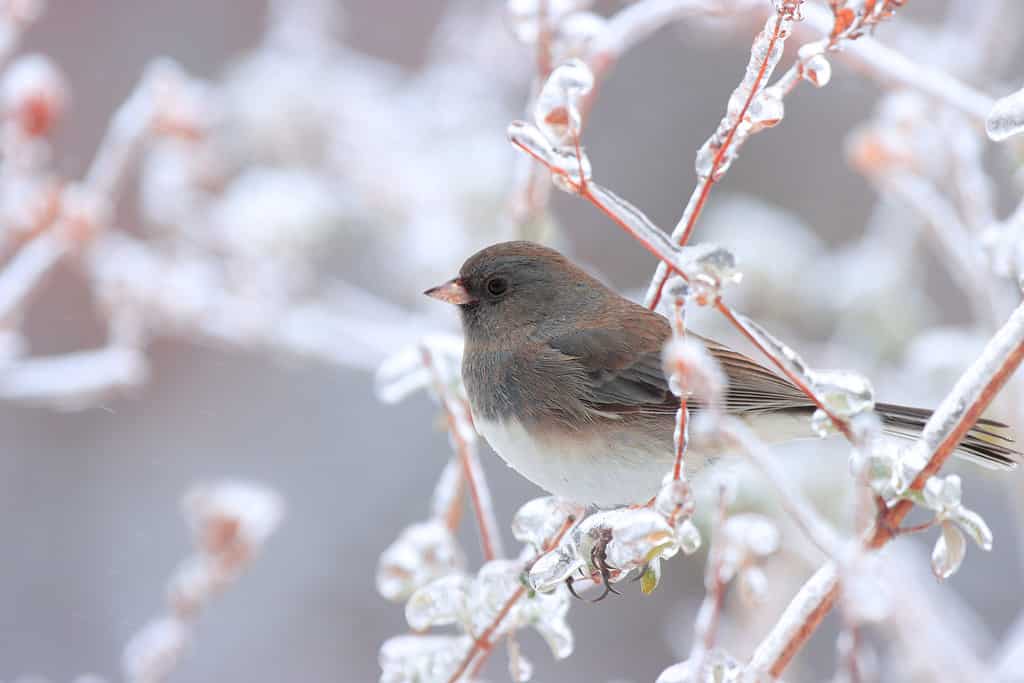
©Walter Coate/Shutterstock.com
Fish
Fish that lived in freshwater bodies, like rivers and lakes, faced the challenge of their habitats freezing over. Some fish survived by slowing down their metabolism and conserving energy until the waters thawed. Other species, such as trout, are better suited to colder water temperatures and can handle the temperature drop.
However, not all fish were so lucky. In some areas where the snow covered the water, the lack of sunlight prevented photosynthesis. This lead to a drop in oxygen levels that made it tough for fish to breathe.
The cold temperatures caused by the storm forced many fish species to resort to winter survival tactics. They decreased their metabolic rate and oxygen consumption rates and remained motionless. Additionally, some species of fish adapted by finding shallow waters warmed by sunlight during the day or areas near springs, which also provided a warmer refuge. These adaptations allowed fish populations to survive until warmer temperatures returned more suitable conditions for them.
Bottom Line
The Biggest Snowstorm to Ever Hit Maryland in March was a catastrophic event. It left a lasting impact on the state. On March 14, 2019, an unrivaled winter storm dropped more than 18 inches of snow in some areas, breaking the record for the most snowfall ever recorded in the state’s history.
In addition to this record-breaking amount of snowfall, powerful winds reaching up to 60 mph caused considerable damage across Maryland. This immense storm resulted in over 300 thousand individuals being left without power. Power loss was caused by debris blocking roads and fallen trees damaging power lines and homes.
This storm brought out the best in Marylanders. Citizens quickly came together to help their neighbors clear blocked roads and remove debris from homes. Though it was a trying experience for many, it was a reminder of how much can be achieved when people unite during such a calamity. All in all, the biggest snowstorm to ever hit Maryland in March was an extraordinary event. It demonstrated just how powerful mother nature can be and will remain one that is remembered for years to come.
The post Discover the Biggest Snowstorm to Ever Hit Maryland in March appeared first on AZ Animals.
from Animal News, Facts, Rankings, and More! - AZ Animals https://ift.tt/xHgiXJv